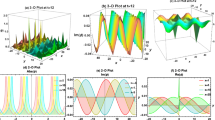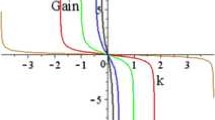Abstract
The nonlinear generalized Chen–Lee–Liu 1+1 evolution equation which describes the propagation of an optical pulse inside a monomode fiber is studied by using the method of Lie symmetries and the singularity analysis. Specifically, we determine the Lie point symmetries of the Chen–Lee–Liu equation and we reduce the equation by using the Lie invariants in order to determine similarity solutions. The solutions that we found have periodic behavior and describe optical solitons. Furthermore, the singularity analysis is applied in order to write algebraic solutions of the Chen–Lee–Liu with the use of Laurent expansions. The latter analysis supports the result for the existence of periodic behavior of the solutions.




Similar content being viewed by others
References
G.W. Bluman, S. Kumei, Symmetries of Differential Equations (Springer, New York, 1989)
H. Stephani, Differential Equations: Their Solutions Using Symmetry (Cambridge University Press, New York, 1989)
P.J. Olver, Applications of Lie Groups to Differential Equations (Springer, New York, 1993)
N.H. Ibragimov, CRC Handbook of Lie Group Analysis of Differential Equations, Volume I: Symmetries, Exact Solutions, and Conservation Laws (CRS Press LLC, Boca Raton, 2000)
L.V. Ovsiannikov, Group Analysis of Differential Equations (Academic Press, New York, 1982)
F.M. Mahomed, A. Qadir, J. Nonlinear Math. Phys. 16, 283 (2009)
H.M. Dutt, M. Safdar, A. Qadir, Arab. J. Math. 8, 163 (2019)
M. Ayub, M. Khan, F.M. Mahomed, Nonlinear Dyn. 67, 2053 (2012)
W. Rui, X. Zhang, Commun. Nonlinear Sci. Num. Sim. 34, 38 (2016)
W. Sarlet, F. Cantrijin, SIAM Rev. 23, 467 (1981)
S.A. Hojman, J. Math. Phys. A Math. Gen. 24, L291 (1992)
P.J. Olver, P. Rosenau, SIAM J. Appl. Math. 47, 263 (1987)
G.M. Webb, G.P. Zank, J. Math. Phys. A Math. Theor. 40, 545 (2007)
M.T. Mustafa, A.Y. Al-Dweik, R.A. Mara’beh, SIGMA 9, 041 (2013)
P.G.L. Leach, J. Math. Phys. 26, 510 (1985)
A. Paliathanasis, M. Tsamparlis, Int. J. Geom. Methods Mod. Phys. 11, 1450037 (2014)
S.V. Meleshko, V.P. Shapeev, J. Nonlinear Math. Phys. 18, 195 (2011)
G.M. Webb, J. Phys. A Math. Gen. 23, 3885 (1990)
C.M. Khalique, A. Biswas, Commun. Nonlinear Sci. Num. Sim. 14, 4033 (2009)
L. Gagnon, B. Grammaticos, A. Ramani, P. Winternitz, J. Phys. A Math. Gen. 22, 499 (1989)
W.I. Fushchych, A.G. Nikitin, J. Math. Phys. 38, 5944 (1997)
X.X. Du, B. Tian, Y.-Q. Yuan, Z. Du, Ann. Phys. 531, 1900198 (2019)
Y. Benia, M. Ruggieri, A. Scapellato, Mathematics 7, 908 (2019)
X. Xin, H. Liu, L. Zhang, Z. Wang, Appl. Math. Lett. 88, 132 (2019)
M. Pandey, Int. J. Nonlinear Sci. Num. Sim. 16, 93 (2015)
J.-G. Liu, Z.-F. Zeng, Y. He, G.-P. Ai, Int. J. Nonlinear Sci. Num. Sim. 16, 114 (2013)
P. Painlevé, Bull. Math. Soc. France 28, 201 (1900)
P. Painlevé, Acta Math. 25, 1 (1902)
P. Painlevé, C. R. Acad. Sci. Paris 143, 1111 (1906)
S. Kowalevski, Acta. Math. 12, 177 (1889)
T. Brugarino, M. Sciacca, Opt. Commun. 262, 250 (2006)
K. Andriopoulos, P.G.L. Leach, J. Math. Anal. Appl. 328, 860 (2007)
K. Andriopoulos, P.G.L. Leach, Appl. Anal. Disc. Math. 5, 230 (2011)
A. Paliathanasis, J.D. Barrow, P.G.L. Leach, Phys. Rev. D 94, 023525 (2016)
R. Conte, Phys. Lett. A 134, 100 (1988)
R. Conte, Phys. Lett. A 140, 383 (1989)
M. Vlieg-Hulstman, Math. Comput. Model. 18, 151 (1993)
S.K. Ivanov, Phys. Rev. A 101, 053827 (2020)
C. Rogers, K.W. Chow, Phys. Rev. E 86, 037601 (2012)
W.H. Lin, E. Kenghe, Schrodinger Equations in Nonlinear Systems (Springer, Singapore, 2019)
A. Hussain, A. Jhangeer, S. Tahir, Y.-M. Chu, I. Khan, K.S. Nisar, Res. Phys. 18, 103208 (2020)
M. Bilal, W. Hu, J. Ren, Eur. Phys. J. Plus 136, 385 (2021)
O. Gonzalez-Gaxiola, A. Biswas, Opt. Quantum Electron. 50, 314 (2018)
G. Xu, M. Confroti, A. Kudlinski, A. Mussot, S. Trillo, Phys. Rev. Lett. 118, 254101 (2017)
K.B. Wolf, Ann. Phys. 172, 1 (1986)
A. Bansal, A. Biswas, A.S. Alshomrani, M. Ekici, Q. Zhou, M.R. Belic, Res. Phys. 15, 102713 (2019)
C.M. Khalique, A. Biswas, J. Electromagn. Waves Appl. 23, 963 (2009)
A. Bansal, A. Biswas, Q. Zhou, S. Arshed, A.K. Alzahrani, M.R. Belic, Phys. Lett. A 384, 126202 (2020)
V.V. Morozov, Izv. Vyss. Uchebn Zavendeni Mat. 5, 161–171 (1958)
G.M. Mubarakzyanov, Izv. Vyss. Uchebn Zavendeni Mat. 32, 114–123 (1963)
G.M. Mubarakzyanov, Izv. Vyss. Uchebn Zavendeni Mat. 34, 99–106 (1963)
G.M. Mubarakzyanov, Izv. Vyss. Uchebn Zavendeni Mat. 35, 104–116 (1963)
J. Ray, J.L. Reid, Phys. Lett. A 71, 317 (1979)
E. Pinney, Proc. Am. Math. Soc. 1, 681 (1950) erm2,erm3,erm4
S. Moyo, P.G.L. Leach, J. Phys. A Math. Gen. 35, 5333 (2002)
A.S.H.F. Mahomed, H.O. Bakodah, Phys. Scr. 96, 035206 (2021)
H. Triki, M.M. Babatin, A. Biswas, Optik 149, 300 (2017)
Z. Xu, L. Li, Z. Li, G. Zhou, Phys. Rev. E 67, 026603 (2003)
A. Hasegawa, M. Matsumoto, Optical Solitons in Fibres, Springer Series in Photonics (Springer, Berlin, 2003)
M.J. Ablowitz, A. Ramani, H. Segur, Lett. Nuovo Cimento 23, 333 (1978)
M.J. Ablowitz, A. Ramani, H. Segur, J. Math. Phys. 21, 715 (1980)
M.J. Ablowitz, A. Ramani, H. Segur, J. Math. Phys. 21, 1006 (1980)
A. Ramani, B. Grammaticos, T. Bountis, Phys. Rep. 180, 159 (1989)
A. Paliathanasis, P.G.L. Leach, IJGMMP 13, 1630009 (2016)
Author information
Authors and Affiliations
Corresponding author
Appendices
Lie symmetries
We briefly discuss the main definition and algorithm for the determination of Lie point symmetries. Consider the one-dimensional parameter point transformation
with generator \(X=\xi ^{i}\left( x^{k},u\right) \partial _{i}+\eta \left( x^{k},u\right) \partial _{u}\), then the differential equation \({\mathbf {H}} \left( x^{k},u,u_{i},u_{ij},\ldots ,u_{i_{1}i_{2}\ldots i_{n}}\right) \) is invariant under the action of the one parameter point transformation if and only if
or equivalently, if there exists a function \(\lambda \) such that the following condition to be true [1, 2, 4]
where \(X^{\left[ n\right] }\) is called the n-th prolongation/extension of X in the jet-space defined as
If X is a symmetry vector for the differential equation \({\mathbf {H}}\), then we can always find a coordinate transformation such that the symmetry vector to be written in the canonical coordinates, i.e., \(X=\partial _{x^{n}}\), where the differential equation is
clear from the last expression it follows \(\partial _{x^{\mu }}H=0\). The coordinate transformation which leads to the canonical coordinates is called similarity transformation and it is mainly applied for the reduction of the differential equation.
One-dimensional optimal system
Let a given differential equation admit as Lie symmetries the elements \( \left\{ X_{1},~X_{2},~\ldots ~X_{n}\right\} \) of the n-dimensional Lie algebra \(G_{n}\) with structure constants \(C_{jk}^{i}\). The two symmetry vectors Z, W defined as
we shall say that are equivalent if and only if [3]
or
Operator \(Ad\left( \exp \left( \epsilon X_{i}\right) \right) X_{j}\) defined as
is called the adjoint representation.
The determination of all the one-dimensional subalgebras of \(G_{n}\) which are not related through the adjoint representation is necessary in order to perform a complete classification of all the possible similarity transformations, i.e., similarity solutions, for a given differential equation. This classification is known as the one-dimensional optimal system.
Singularity analysis
The development of the Painlevé test for the determination of integrability of a given equation or system of equations and its systematization been succinctly summarized by Ablowitz, Ramani and Segur in the so-called ARS algorithm [60,61,62]. The ARS algorithm is constructed by three basic steps, they are: (a) determine the leading-order term which describes the behavior of the solution near the singularity, (b) find the position of the resonances which shows the existence and the position of the integration constants and (c) write a Laurent expansion with leading-order term determined in the first step in order to perform the consistency test and the solution, for a review on the ARS algorithm and various applications we refer the reader in [63], while in [64] a discussion between the Lie’s approach and the singularity analysis is given.
Rights and permissions
About this article
Cite this article
Paliathanasis, A. Periodic solutions from Lie symmetries for the generalized Chen–Lee–Liu equation. Eur. Phys. J. Plus 136, 934 (2021). https://doi.org/10.1140/epjp/s13360-021-01945-4
Received:
Accepted:
Published:
DOI: https://doi.org/10.1140/epjp/s13360-021-01945-4




